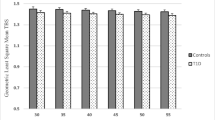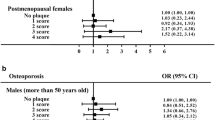Abstract
Literature data reported that in elderly subjects, carotid intima-media thickness (IMT) was negatively associated with bone mineral density (BMD). Paradoxically, type-2 diabetes (T2DM) patients, despite having higher BMD, present an increased risk of fragility fractures and cardiovascular complications. Some studies have reported trabecular bone score (TBS), an index of trabecular bone quality, as possibly being reduced in T2DM. This study aimed to evaluate whether in T2DM subjects TBS was better associated with IMT with respect to BMD. In 131 consecutive T2DM subjects (55 men and 76 women; mean age: 60.0 ± 7.3 years) and 265 consecutive non-T2DM subjects (107 men and 158 women; mean age: 58.9 ± 7.8 years) we measured carotid IMT by high-resolution ultrasonography and BMD at lumbar spine (LS-BMD), at femoral neck FN-BMD and total hip TH-BMD; TBS was calculated using TBS iNsight software. LS-BMD, FN-BMD, and TH-BMD were all significantly higher in T2DM than in non-T2DM subjects, whereas TBS was significantly lower in T2DM subjects than in controls and inversely correlated with diabetes duration. In T2DM subjects multiple regression analysis showed that IMT was positively associated with age (b = 0.017; p < 0.001) and inversely associated with TBS (b = −0.473; p = 0.038). In non-T2DM subjects, only age was positively associated with IMT. To sum up, T2DM subjects present higher values of BMD and lower values of TBS with respect to non-diabetic controls. Moreover, in T2DM subjects TBS was found to be independently associated with carotid IMT. These findings suggest that TBS may not only capture bone fragility-related factors, but also some information associated with greater risk of developing cardiovascular diseases.


Similar content being viewed by others
References
Von der Recke P, Hansen MA, Hassager C (1999) The association between low bone mass at the menopause and cardiovascular mortality. Am J Med 106:273–278. doi:10.1016/S0002-9343(99)00028-5
Kiel DP, Kauppila LI, Cupples LA, Hannan MT, O’Donnell CJ, Wilson PW (2001) Bone loss and the progression of abdominal aortic calcification over a 25 year period: the Framingham Heart Study. Calcif Tissue Int 68:271–276. doi:10.1007/BF02390833
Vassalle C, Mazzone A (2016) Bone loss and vascular calcification: a bi-directional interplay? Vasc Pharmacol 86:77–86. doi:10.1016/j.vph.2016.07.003
Tanko LB, Christiansen C, Cox DA, Geiger MJ, McNabb MA, Cummings SR (2005) Relationship between osteoporosis and cardiovascular disease in postmenopausal women. J Bone Miner Res 20:1912–1920. doi:10.1359/JBMR.050711
Varri M, Tuomainen TP, Honkanen R, Rikkonen T, Niskanen L, Kröger H, Tuppurainen MT (2014) Carotid intima-media thickness and calcification in relation to bone mineral density in postmenopausal women-the OSTPRE-BBA study. Maturitas 78:304–309. doi:10.1016/j.maturitas.2014.05.017
O’ Leary DH, Polak JF, Kronmal RA, Manolio TA, Burke GL, Wolfson SK Jr (1999) Carotid-artery intima and media thickness as a risk factor for myocardial infarction and stroke in older adults. Cardiovascular Health Study Collaborative Research Group. N Engl J Med 340:14–22. doi:10.1056/NEJM199901073400103
Schwartz AV, Sellmeyer DE, Ensrud KE, Study of Osteoporotic Features Research Group et al (2001) Older women with diabetes have an increased risk of fracture: a prospective study. J Clin Endocrinol Metab 86:32–38. doi:10.1210/jcem.86.1.7139
Janghorbani M, Van Damm RM, Willett WC et al (2007) Systematic review of type 1 and type 2 diabetes mellitus and risk of fracture. Am J Epidemiol 166:495–505. doi:10.1093/aje/kwm106
Schwartz AV, Garnero P, Hillier TA et al (2009) Pentosidine and increased fracture risk in older adults with type 2 diabetes. J Clin Endocrinol Metab 94:2380–2386. doi:10.1210/jc.2008-2498
Leslie WD, Aubry-Rozier B, Lamy O, Hans D, Manitoba Bone Density Program (2013) TBS (trabecular bone score) and diabetes-related fracture risk. J Clin Endocrinol Metab 98:602–609. doi:10.1210/jc.2012-3118
Napoli N, Strotmeyer ES, Ensrud KE et al (2014) Fracture risk in diabetic elderly men: the MrOS study. Diabetologia 57:2057–2065. doi:10.1007/s00125-014-3289-6
Bousson V, Bergot C, Sutter B, Levitz P, Cortet B, Scientific Committee of the Groupe de Recherche et d’Information sur les Ostéoporoses (2012) Trabecular bone score (TBS): available knowledge, clinical relevance, and future prospects. Osteoporos Int 23:1489–1501. doi:10.1007/s00198-011-1824-6
Ulivieri FM, Silva BC, Sardanelli F, Hans D, Bilezikian JP, Caudarella R (2014) Utility of the trabecular bone score (TBS) in secondary osteoporosis. Endocrine 47:435–448. doi:10.1007/s12020-014-0280-4
Silva BC, Leslie WD, Resch H et al (2014) Trabecular bone score: a noninvasive analytical method based upon the DXA image. J Bone Miner Res 29:518–530. doi:10.1002/jbmr.2176
Harvey NC, Glüer CC, Binkley N et al (2015) Trabecular bone score (TBS) as a new complementary approach for osteoporosis evaluation in clinical practice. Bone 78:216–224. doi:10.1016/j.bone.2015.05.016
McCloskey EV, Odén A, Harvey NC et al (2016) A meta-analysis of trabecular bone score in fracture risk prediction and its relationship to FRAX. J Bone Miner Res 31:940–948. doi:10.1002/jbmr.2734
Iki M, Fujita Y, Tamaki J et al (2015) Trabecular bone score may improve FRAX® prediction accuracy for major osteoporotic fractures in elderly Japanese men: the Fujiwara-kyo Osteoporosis Risk in Men (FORMEN) Cohort Study. Osteoporos Int 26:1841–1848. doi:10.1007/s00198-015-3092-3
Bonaccorsi G, Fila E, Messina C et al (2016) Comparison of trabecular bone score and hip structural analysis with FRAX® in postmenopausal women with type 2 diabetes mellitus. Aging Clin Exp Res. doi:10.1007/s40520-016-0634-2
Zhukouskaya VV, Eller-Vainicher C, Gaudio A et al (2016) The utility of lumbar spine trabecular bone score and femoral neck bone mineral density for identifying asymptomatic vertebral fractures in well-compensated type 2 diabetic patients. Osteoporos Int 27:421. doi:10.1007/s00198-015-3248-1
Kim JH, Choi HJ, Ku EJ et al (2015) Trabecular bone score as an indicator for skeletal deterioration in diabetes. J Clin Endocrinol Metab 100:475–482. doi:10.1210/jc.2014-2047.100:475-482
Montomoli M, Gonnelli S, Giacchi M et al (2002) Validation of a food frequency questionnaire for nutritional calcium intake assessment in Italian women. Eur J Clin Nutr 56:21–30. doi:10.1038/sj/ejcn/1601278
Gonnelli S, Rossi S, Montomoli M et al (2009) Accuracy of different reduced versions of a validated food-frequency questionnaire in italian men and women. Calcif Tissue Int 85:221–227. doi:10.1007/s00223-009-9264-4
Winckler K, Tarnow L, Lundby-Christensen L, CIMT Trial Group et al (2015) Vitamin D, carotid intima-media thickness and bone structure in patients with type 2 diabetes. Endocr Connect 4:128–135. doi:10.1530/EC-15-0034
Sibal L, Agarwal SC, Home PD (2011) Carotid intima-media thickness as a surrogate marker of cardiovascular disease in diabetes. Diabetes Metab Syndr Obes 19(4):23–34. doi:10.2147/DMSO.S8540
Fodor D, Fodor D, Bondor C et al (2011) Relation between intima-media thickness and bone mineral density in postmenopausal women: a cross-sectional study. Sao Paulo Med J 129:139–145. doi:10.1590/S1516-31802011000300004
Tamaki J, Iki M, Hirano Y et al (2009) Low bone mass is associated with carotid atherosclerosis in postmenopausal women: the Japanese Population-based Osteoporosis (JPOS) Cohort Study. Osteoporos Int 20:53–60. doi:10.1007/s00198-008-0633-z
Aoyagi K, Ross PD, Orloff J, Davis JW, Katagiri H, Wasnich RD (2001) Low bone density is not associated with aortic calcification. Calcif Tissue Int 69:20–24. doi:10.1007/s002230020003
Patsch JM, Burghardt AJ, Yap SP et al (2013) Increased cortical porosity in type 2 diabetic postmenopausal women with fragility fractures. J Bone Miner Res 28:313–324. doi:10.1002/jbmr.1763
Gonnelli S, Caffarelli C, Giordano N, Nuti R (2015) The prevention of fragility fractures in diabetic patients. Aging Clin Exp Res 27:115–124. doi:10.1007/s40520-014-0258-3
Villegas-Rodríguez ME, Uribarri J, Solorio-Meza SE et al (2016) The AGE-RAGE axis and its relationship to markers of cardiovascular disease in newly diagnosed diabetic patients. PLoS ONE 19(11):e0159175. doi:10.1371/journal.pone.0159175
de Vos LC, Lefrandt JD, Dullaart RP, Zeebregts CJ, Smit AJ (2016) Advanced glycation end products: an emerging biomarker for adverse outcome in patients with peripheral artery disease. Atherosclerosis 254:291–299. doi:10.1016/j.atherosclerosis.2016.10.012
García-Martín A, Rozas-Moreno P, Reyes-García R et al (2012) Circulating levels of sclerostin are increased in patients with type 2 diabetes mellitus. J Clin Endocrinol Metab 97:234–241. doi:10.1210/jc.2011-2186
Morales-Santana S, García-Fontana B, García-Martín A et al (2013) Atherosclerotic disease in type 2 diabetes is associated with an increase in sclerostin levels. Diabetes Care 36:1667–1674. doi:10.2337/dc12-1691
Garcia-Martín A, Reyes-Garcia R, García-Fontana B et al (2014) Relationship of Dickkopf1 (DKK1) with cardiovascular disease and bone metabolism in Caucasian type 2 diabetes mellitus. PLoS ONE 9:e111703. doi:10.1371/journal.pone.0111703
Gonnelli S, Caffarelli C, Tanzilli L, Pondrelli C, Lucani B, Franci BM, Nuti R (2014) Effects of intravenous zoledronate and ibandronate on carotid intima-media thickness, lipids and FGF-23 in postmenopausal osteoporotic women. Bone 61:27–32. doi:10.1016/j.bone.2013.12.017
Majundar SR, Leslie WD, Lix LM et al (2016) Longer duration of diabetes strongly impacts fracture risk assessment: the manitoba BMD cohort. J Clin Endocrinol Metab 101:4489–4496. doi:10.1210/jc.2016-2569
Targher G, Bertolini L, Padovani R et al (2006) Serum 25-hydroxyvitamin D3 concentrations and carotid artery intima-media thickness among type 2 diabetic patients. Clin Endocrinol 65:593–597. doi:10.1111/j.1365-2265.2006.02633.x
Amnuaywattakorn S, Sritara C, Utamakul C et al (2016) Simulated increased soft tissue thickness artefactually decreases trabecular bone score: a phantom study. BMC Musculoskelet Disord 13(17):17. doi:10.1186/s12891-016-0886-1
Author information
Authors and Affiliations
Corresponding author
Ethics declarations
Conflict of interest
C. Caffarelli, A. Giambelluca, V. Ghini, V. Francolini, M. D. Tomai Pitinca, R. Nuti, and S. Gonnelli declare that they have no conflict of interest.
Human and Animal Rights and Informed Consent
The study was conducted in accordance with the ethics principles of the Declaration of Helsinki and was approved by the Ethics Committee of Siena University Hospital.
Rights and permissions
About this article
Cite this article
Caffarelli, C., Giambelluca, A., Ghini, V. et al. In Type-2 Diabetes Subjects Trabecular Bone Score is Better Associated with Carotid Intima-Media Thickness than BMD. Calcif Tissue Int 101, 404–411 (2017). https://doi.org/10.1007/s00223-017-0297-9
Received:
Accepted:
Published:
Issue Date:
DOI: https://doi.org/10.1007/s00223-017-0297-9




